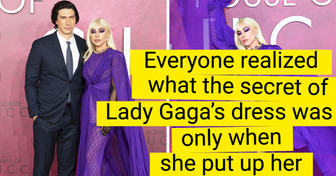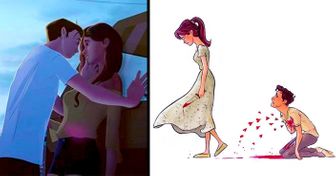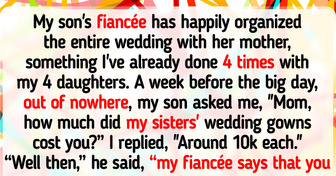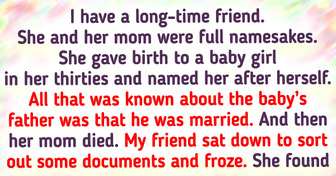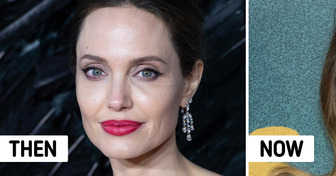18 People Who Just Can’t Keep Their Creativity Inside

One of the indubitable favorite things about watching historical films are the vibrant and attractive costumes. Big dresses with lots of jewelry, and complex hairstyles look amazing on the screen. But sometimes, movie creators get carried away and make some obvious mistakes.
In Mary Queen of Scots, that tells the story of a difficult relationship between Queen Elizabeth I and Mary Stewart, actress Saoirse Ronan appears with a lot of different jewelry. For example, there are 5 earrings in her right ear. Even though there’s proof that in the 16th century, women would wear several earrings, there’s no mention of Mary Stewart doing that. This is why it looks too modern and inaccurate.
The novel War & Peace is set at the beginning of the 19th century. But the dress we see on Anna Pavlovna Scherer couldn’t have appeared until the 1950s. The missing sleeve, naked back — none of this is accurate for the fashion of that time period.
The director of The Great Gatsby Baz Luhrmann was quite deliberate about the depiction of 1920s fashion. The dresses Daisy wears look too modern. The silhouette is supposed to be looser, the cleavage should be square-shaped, and the cut on the back would have been deeper.
Becoming Jane is set at the end of the 18th century, when fashion in England was changing. During these years, women would wear close-fitting dresses with wide skirts. So, Jane’s clothes look truly revolutionary. And this style wouldn’t become popular until 10-20 years later — the skirt also looks too narrow, even for 1810.
Little Women was criticized heavily for the hairstyles of the main characters. They appear with loose and uncovered hair.
And some of the costumes also look strange. For example, in the book, Meg comes to the ball in a provocative dress. And in the film, it looked much more simple. The cleavage was supposed to be deeper and the shoulders — open. So, this scene is kind of pointless.
In the 16th century, ladies would always wear a chemise under a dress, but in The Tudors, women don’t wear one. For example, Gabrielle Anwar wears a bright dress with nothing under it. The neckline was usually square at the time, and the dress would consist of several parts. So, it’s hard to imagine a woman from that year in a dress with open shoulders.
Pompeii is set in the 1st century. At the time, only the emperor could wear purple.
If someone else wore purple, they would be punished. So, when senator Corvus appears onscreen in purple clothing, that should’ve meant you’d soon be worrying about his future. And he wasn’t the only one wearing purple, his soldiers were also decked out in it.
In the 16th century, women would decorate doublets or skirts with embroidery. And they would choose a complex pattern, not just one giant motif. This is why Natalie Dormer’s dress in The Tudors looks unrealistic.
The film about the life of the writer Mary Shelley had both positive and negative reviews from critics. One of the reasons for the criticism was the clothing of the main character. They looked like a more modern version of what women really wore at the beginning of the 19th century.
Costume designers preferred linen to cotton and wool, so all the dresses look wrinkled and shapeless. This pink costume is probably the worst in the entire film. The wrinkles, the knitted blouse — none of these things look authentic for the time period.
Farewell, My Queen shows life in the French court at the end of the 18th century. Women wear all sorts of bright clothes. For example, Virginie Ledoyen wears this amazing green dress. Of course, fabrics were dyed in the past, but it was almost impossible to achieve such a vibrant color. Usually, colors would be softer and more muted.
Pirates of the Caribbean: The Curse of the Black Pearl is set at the beginning of the 18th century. And Elizabeth’s hat looks quite authentic. Straw hats would often be tied with ribbons, but they are supposed to be underneath, not on the top of the hat. Nobody would curve down the shape of the hat.
The creators of Love & Friendship were very careful with the men’s suits for the film. Most of them look authentic and reflect the changes happening to the main character. But costume designers still took some liberties. At that time, there were no lace overgowns.
Even though Bridgerton doesn’t try to be historically authentic, most of the time, the characters’ looks match the time period. But the hairstyles are sometimes off. At the time, women would always curl their bangs. So, when Daphne has straight locks, covering her forehead, she looks more like Natasha Rostova played by Audrey Hepburn, than a girl of the Regency era.
The series The Spanish Princess is about the life of Catherine of Aragon, who was the first wife of Henry VIII. In one of the episodes, the queen has to protect her new land herself, so she wears armor. It’s possible that women would lead a military campaign or participate in battles. But there’s no evidence that, in the Middle Ages, women had special armor.
A breastplate that conformed to a woman’s body could be dangerous. The point of armor is to deflect a sword that would just slide on metal. And if someone used a breastplate like Catherine of Aragon did in the film, the results would be devastating.
In historical movies, you can often see female characters in dresses with lacing. But in the 15th century, it was only functional and never decorative. It’s hard to imagine a woman that would spend a lot of time every day lacing up the front, back, and sleeves. In the 15th century, there were no dresses similar to the one we saw in The White Princess.
In your opinion, the costumes in historical movies should be attractive and vibrant or realistic?

